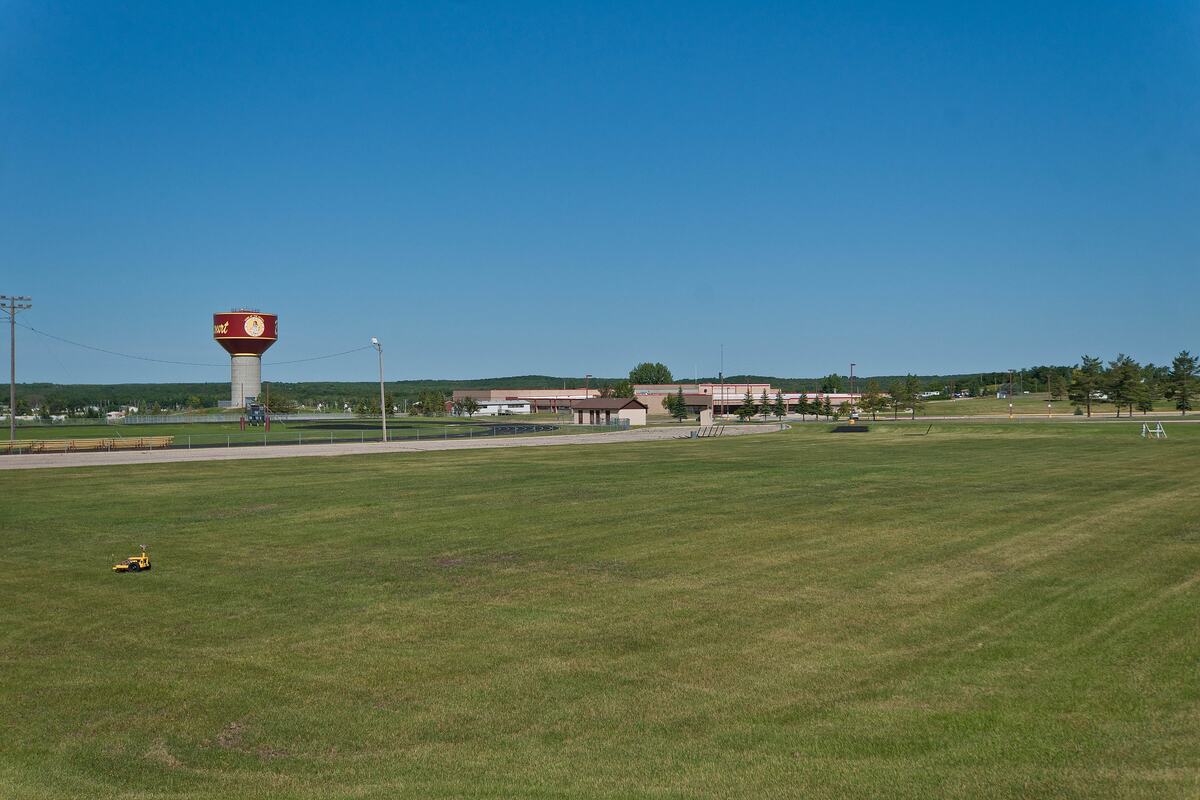
As a resident of the Peace Garden State, you’re no stranger to the beauty and challenges of the Great Plains. From the sweeping prairies to the rugged Badlands, this state is filled with natural wonders that draw visitors worldwide. But if you’re a homeowner, you might wonder what the best grass seeds are for North Dakota.
With scorching summers and freezing winters, finding the right type of grass to thrive in this region is a must if you want to cultivate a lush, green lawn. But don’t worry, we’ve done the research for you, so let’s get started!
And later, we’ll help you choose the best grass type for your North Dakota lawn.
Cool-Season Grasses
Kentucky Bluegrass

Photo Credit: Matt Lavin / Flickr / CC BY-SA 2.0
Cool-season grasses are the most common choice for North Dakota lawns because they withstand the state’s low winter temperatures. And when it comes to cool-season grasses, Kentucky bluegrass is by far the most popular and widely used species in North Dakota.
Kentucky bluegrass is hardy and durable, with a fine texture that gives lawns a luxurious look. In addition, Kentucky bluegrass can thrive in cold weather conditions and withstand temperature fluctuations that are common in this region.
Classification: Cool-season grass
Spreads by: Rhizomes
Shade tolerance: Low
Drought tolerance: Moderate
Foot traffic tolerance: Moderate
Maintenance needs: Moderate mowing frequency and high fertilization needs (mulch can be used).
Mowing height: Set mowing height between 2.5 and 3.5 inches.
Potential for disease: Moderate to high; prone to several diseases, such as dollar spot, leaf spot, necrotic ring spot, summer patch, and stripe smut.
Soil pH: 6-7.5
Soil type: Performs best in well-drained, heavy soils with high fertility.
Other notes: Since Kentucky bluegrass takes 21 days to germinate, it is often mixed with perennial ryegrass, which takes five days.
Grass Seed Options:
– Jonathan Green (11970) Blue Panther Kentucky Bluegrass Grass Seed (3 lbs.)
– SeedRanch Midnight Kentucky Bluegrass Seed (5 lbs.)
Perennial Ryegrass
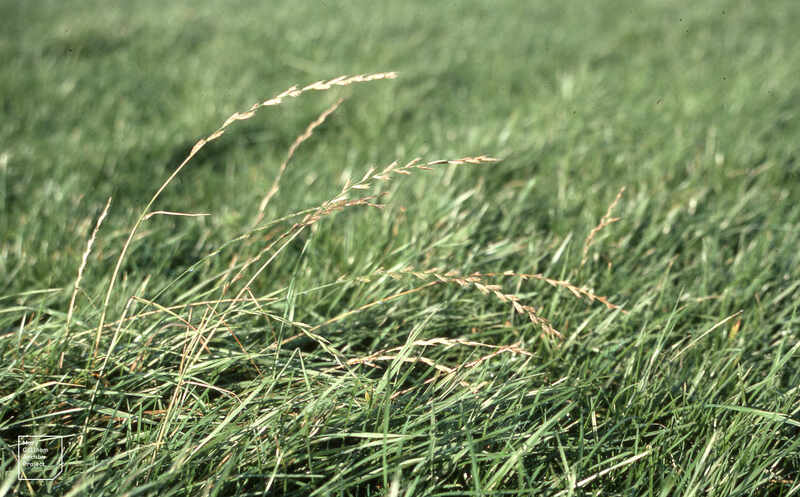
Photo Credit: Dr Mary Gillham Archive Project / Flickr / CC BY 2.0
Another excellent option for homeowners and landscapers in North Dakota is perennial ryegrass. This grass seed is known for its ability to germinate and establish quickly, which is why it is often added in seed mixes with other grass species to create a lush, durable lawn.
One of the most attractive features of perennial ryegrass is its wear tolerance. This grass is highly durable and can withstand heavy foot traffic, making it an ideal choice for families who love outdoor activities like sports and barbecues.
Classification: Cool-season grass
Spreads by: Has a bunch-type growth habit
Shade tolerance: Low
Drought tolerance: Low
Foot traffic tolerance: High
Maintenance needs: Moderate mowing and fertilization requirements. Thatch is not significant.
Mowing height: Set mowing height to 1.5 to 2.5 inches
Potential for disease: High. Common diseases include gray leaf spot, red thread, and leaf spot/melting-out.
Soil pH: Can grow in soils with a pH between 5 and 8, but prefers between 6 and 7.
Soil type: Prefers good drainage and fertility but can tolerate some poor drainage.
Other notes: There is another type of ryegrass — annual ryegrass — but if planted in North Dakota, it will die in its first winter.
Grass Seed Options:
– Outsidepride Perennial Ryegrass Seed (5 lbs.)
– Eretz ProTurf Perennial Ryegrass Fine Lawn Seed (choose your size)
Fine Fescues
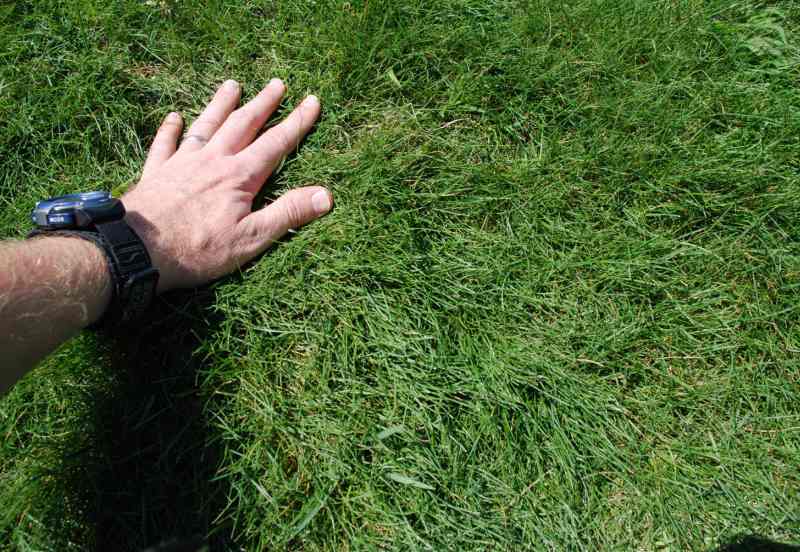
Aaron J. Patton, Ph.D. / Turfgrass Extension Specialist at Purdue University
Fine fescues are a popular option for homeowners and landscapers in North Dakota looking for a fine-leaf grass seed adaptable to various conditions. The most common fine fescues in North Dakota include hard fescue, Chewings red, and creeping red.
Fine fescues are often seeded with other cool-season grasses to create a diverse, durable lawn that can withstand the state’s harsh weather conditions and is relatively low-maintenance.
Classification: Cool-season grass
Spreads by: Creeping red fescue spreads by rhizomes, while other fine fescues are bunch-type grasses, such as Chewings, hard, and sheep fescues.
Shade tolerance: Moderate to High, depending on species
Drought tolerance: Moderate to High, depending on species
Foot traffic tolerance: Low to Moderate, depending on species
Maintenance needs: Low fertilizer and mowing needs
Mowing height: Set mowing height between 2.5 and 4 inches, depending on species.
Potential for disease: Moderate. Common diseases include red thread, leaf spot, dollar spot, summer patch, and powdery mildew.
Soil pH: 6-6.5
Soil type: Will not perform well in wet soil conditions. Prefers drier soils and tolerates a wide range of soil types and fertility.
Other notes: Chewings fescue is the most shade-tolerant species. Hard fescues have extensive root systems that make them the most drought-tolerant.
Grass Seed Options:
– Outsidepride Legacy Fine Fescue Grass Seed (5 lbs.)
– Eretz Creeping Red Fine Fescue Seed (choose your size)
– Outsidepride Creeping Red Fine Fescue Grass Seed (25 lbs.)
– Outsidepride Hard Fine Fescue Grass Seed (10 lbs.)
Tall Fescue

Aaron J. Patton, Ph.D. / Turfgrass Extension Specialist at Purdue University
Another grass seed that performs well in North Dakota’s climate is tall fescue. This grass seed is known for its tolerance to cold, heat, and drought, making it a hardy choice for the state’s hot summers and cold winters.
Tall fescue has a medium to dark green color and a finer leaf texture than other cool-season grasses. This turfgrass grows quickly and establishes rapidly, which is great for those looking for a quick lawn establishment. However, it does require frequent mowing due to its fast growth rate.
Classification: Cool-season grass
Spreads by: Produces short rhizomes but has a bunch-type growth habit
Shade tolerance: Moderate
Drought tolerance: Moderate to High
Foot traffic tolerance: Moderate
Maintenance needs: Frequent mowing. Does not produce significant thatch.
Mowing height: Set mowing height to 2 inches when grass reaches 3 inches tall.
Potential for disease: Tolerant of most diseases when properly maintained.
Soil pH: 5.5-6.5
Soil type: Adapted to a wide range of soil conditions, but prefers fertile clay soils with good drainage.
Other notes: Low-cost tall fescue cultivars like Kentucky 31 will often be coarse and look clumpy, affecting the overall appearance of the lawn. Opt for turf-type tall fescue cultivars instead.
Grass Seed Options:
– Triple-Play Tall Fescue Grass Seed Blend (5000 sq ft)
– Eretz Kentucky 31 K31 Tall Fescue Grass Seed (choose your size)
– Pennington The Rebels Tall Fescue Grass Seed Mix (7 lb.)
Warm-Season Grasses
Buffalograss
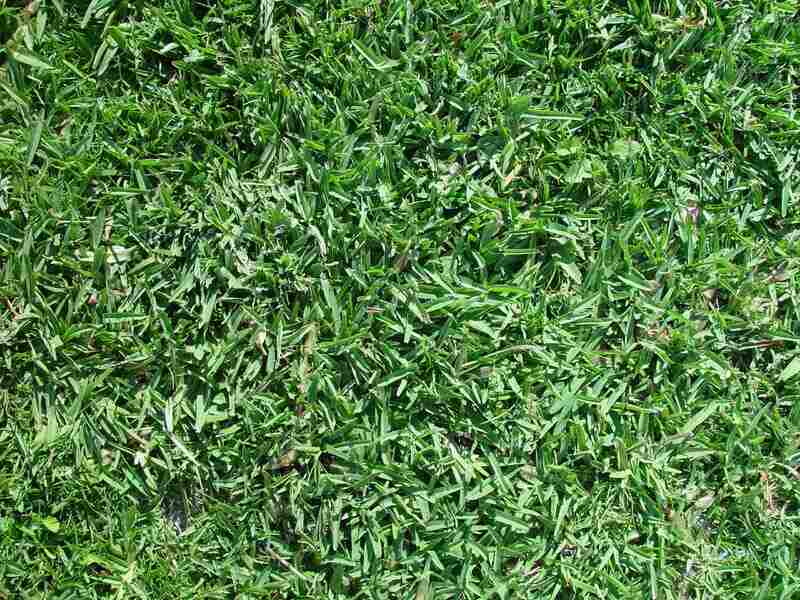
Photo Credit: Pixnio
While warm-season grasses are not commonly found in North Dakota, buffalograss is an exception. This native grass has the best cold hardiness of all warm-season grasses and can survive the state’s harsh winters by entering a period of dormancy. As a result, buffalograss has a very short growing season and a long period of dormancy in this state.
Buffalograss is known for its low-maintenance needs, making it a popular choice for those who want a beautiful lawn but don’t have much time to care for it. It has low mowing and fertilizing requirements, but will be invaded by weeds if overwatered.
Classification: Warm-season grass
Spreads by: Stolons
Shade tolerance: Low, thrives in full sun
Drought tolerance: High
Foot traffic tolerance: Low
Maintenance needs: Low fertilizer and mowing needs. Requires weed control.
Mowing height: Set the mowing height between 2 and 3 inches.
Potential for disease: Good tolerance against diseases and insects
Soil pH: 6.5-7.5
Soil type: Native clay soils, not sandy soils
Other notes: Don’t get this grass type if you mind having a tan or brown lawn for half a year.
Grass Seed Options:
– Everwilde Farms Buffalograss Seeds (1 lb. of seeds)
– Buffalograss seed (primed) (5-lb. bag)
Blue Grama
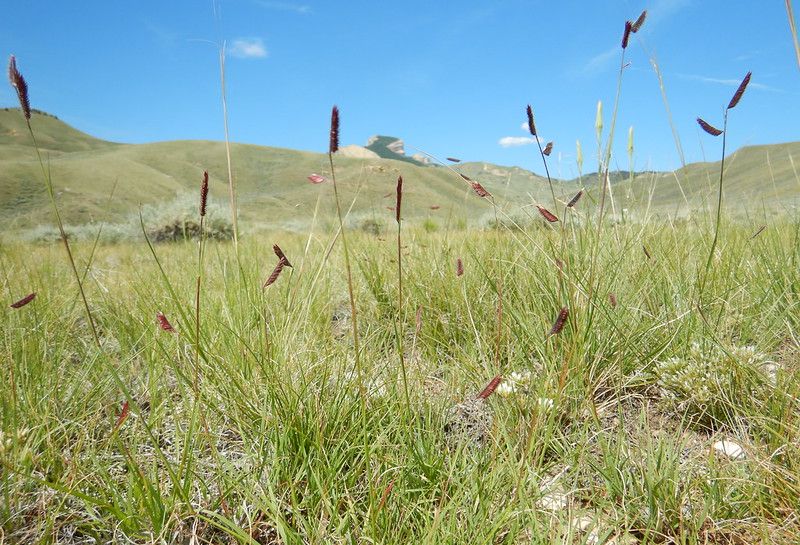
Photo credit: Matt Lavin / Flickr / CC BY-SA 2.0
Blue grama is a native warm-season grass that is well-suited to the climate of North Dakota thanks to its cold and heat tolerance. Like buffalograss, blue grama has a short growing season and a long dormancy period.
One of the main benefits of blue grama is its low-maintenance needs. This grass is slow to establish, but it requires very little care once it takes root. In addition, it is drought-resistant and does not require frequent watering, making it a great choice for homeowners who want a beautiful lawn without the hassle of constant maintenance.
Classification: Warm-season
Spreads by: Rhizomes
Shade Tolerance: Low, thrives in full sun
Drought Tolerance: High
Foot Traffic Tolerance: Low
Maintenance Needs: Low maintenance requirements
Mowing Height: Set mowing height between 2 and 3 inches
Potential for Disease: Low to Moderate. Its most prevalent disease is fungal rust.
Soil pH: 6.6-8.4
Soil Type: Tolerates a wide-range of soil textures, including clays and sandy or gravelly loams. Does not perform well in wet, poorly drained soils.
Other notes: Bad River blue grama is the most used variety throughout the Great Plains.
Grass Seed Options:
– Everwilde Farms Blue Grama Grass Seeds (1 lb.)
– Nature’s Seed Blue Grama Grass Seeds (1 lb.)
How to Choose the Best Grass Type for Your North Dakota Lawn
Maintenance Needs
If you want your lawn to thrive, it’s essential to consider how much time and effort you’re willing to invest in its upkeep. Choose low-maintenance grasses if you don’t want to spend all your weekend toiling away on your lawn.
High-maintenance grasses: Kentucky bluegrass
Moderate-maintenance grasses: Perennial ryegrass, tall fescue
Low-maintenance grasses: Buffalograss, blue grama, fine fescues
Wear Tolerance
If you have a busy household with kids and pets running around, you’ll want to choose a durable grass seed that can withstand heavy foot traffic. Nobody wants a lawn that turns into a muddy mess after just a few games of tag or fetch!
High wear tolerance: Perennial ryegrass
Moderate wear tolerance: Kentucky bluegrass, tall fescue
Low wear tolerance: Buffalograss, blue grama, fine fescues
Shade Tolerance
Different grass types have varying levels of shade tolerance, and choosing a grass seed that is not suited to your yard’s level of shade can result in a patchy, unhealthy lawn. By assessing your yard’s level of shade, you can make an informed decision about which grass seed will thrive in it.
High shade tolerance: Fine fescues (especially Chewings fescue)
Moderate shade tolerance: Tall fescue
Low shade tolerance: Kentucky bluegrass, perennial ryegrass, buffalograss, blue grama
When to Bring in the Pros
Choosing the perfect grass type for your new lawn can be daunting in North Dakota, but you don’t have to do it alone! Instead, call a LawnStarter lawn care pro near you.
Main Image Credit: Andrew Filer / Wikimedia Commons / CC BY-SA 2.0
LawnStarter participates in the Amazon Services LLC Associates Program, an affiliate advertising program. LawnStarter may earn revenue from products promoted in this article.